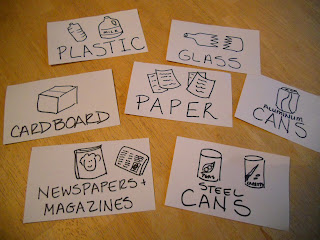Ecology is: 1. the branch of biology that deals with the relations of organisms to one another, and 2. The study of the interaction of people with their environment.
 |
| You'd "B" Crazy Not To Try This Recycling Craft! (GROAN!) |
I started off having the children play with blocks. We talked about how we needed to share the blocks. If one person took all of the blocks, there wouldn't be enough for everyone. This is a good way to illustrate the concept of REDUCE. If you use less, everyone can have some. Then I talked a bit about how people and nature can be connected. If we go on a picnic and throw our trash on the ground it will dirty up the environment and outside is where animals live--it is their home! Imagine our homes filled with trash! YUCK!
So we went outside with a shopping bag and looked for trash. They were good at that game and found quite a bit! We also talked about biodegradable vs. non-biodegradable. Leaves will break down over time, but a plastic coffee cup will not.
We went back inside and I introduced the next concept: RECYCLE. If we threw everything away or landfills will fill up quickly, and some of the stuff we throw away is still good or can be turned into something else. For example, water bottles can be turned into Polar Fleece fabric. I had a bunch of different recyclables on hand, in a pile, to show them. I had a ton of categories for them to sort the recyclables into (our town has a wonderful recycling center!). I had seven bins with labels such as:
- Paper
- Plastic
- Cardboard (Corrugated)
- Steel Cans
- Aluminum Cans (Soda cans)
- Newspaper/Magazines
- Glass (be careful with that!)
 |
| Here are my basic labels for the Recycling Bins |
Then they sorted the recyclables into the appropriate bins. This went quite fast! I explained that other things can also be recycled: clothing, books and toys, by giving them away to someone who may need them.
On to the art project!
Recycled Letters
Supplies Needed:
- Poster board (we used black)
- Scraps of construction paper, magazines, newspapers, labels from cans, etc.
- Glue stick
- Scissors (young children can rip the paper if they aren't ready for scissors).
1. Cut the first letter of the child's name from poster board. It should be about 10 inches tall and wide enough so that s/he has space to glue paper to the surface.
2. Have the child use the glue stick to attach bits of paper to the surface of the letter.
This project REUSES paper that normally would have been thrown away.
We then went back to the pond onsite and looked for trash and critters. We found water bugs and a frog and we also saw trash that we couldn't reach, floating in the pond, such as a tennis ball. This allowed me to reiterate the information I had talked about earlier about how humans and nature are connected and how our actions affect other living things.
Home Connections
To strengthen the learning this lesson at home, parents can do the following:
- Discuss with children how they can be kind and not so kind to the environment.
- Set up a recycling station at home and visit the Recycling Center in their town.
- Look through outgrown toys, books and clothing and donate the items to those in need.
- Go on a hike and/or picnic and be good stewards by staying on the paths and carrying out their trash and disposing of it properly.
No comments:
Post a Comment